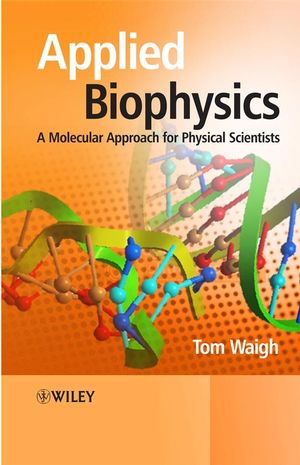Applied Biophysics: A Molecular Approach for Physical ScientistsISBN: 978-0-470-01717-3
Hardcover
440 pages
September 2007
 This is a Print-on-Demand title. It will be printed specifically to fill your order. Please allow an additional 10-15 days delivery time. The book is not returnable.
|
||||||
Acknowledgements.
1 The Building Blocks.
1.1 Proteins.
1.2 Lipids.
1.3 Nucleic Acids.
1.4 Carbohydrates.
1.5 Water.
1.6 Proteoglycans and Glycoproteins.
1.7 Cells (Complex Constructs of Biomolecules).
1.8 Viruses (Complex Constructs of Biomolecules).
1.9 Bacteria (Complex Constructs of Biomolecules).
1.10 Other Molecules.
Further Reading.
Tutorial Questions.
2 Mesoscopic Forces.
2.1 Cohesive Forces.
2.2 Hydrogen Bonding.
2.3 Electrostatics.
2.3.1 Unscreened Electrostatic Interactions.
2.3.2 Screened Electrostatic Interactions.
2.3.3 The Force Between Charged Spheres in Solution.
2.4 Steric and Fluctuation Forces.
2.5 Depletion Forces.
2.6 Hydrodynamic Interactions.
2.7 Direct Experimental Measurements of Intermolecular and Surface Forces.
Further Reading.
Tutorial Questions.
3 Phase Transitions.
3.1 The Basics.
3.2 Helix–Coil Transition.
3.3 Globule–Coil Transition.
3.4 Crystallisation.
3.5 Liquid–Liquid Demixing (Phase Separation).
Further Reading.
Tutorial Questions.
4 Liquid Crystallinity.
4.1 The Basics.
4.2 Liquid–Nematic–Smectic Transitions.
4.3 Defects.
4.4 More Exotic Possibilities for Liquid Crystalline Phases.
Further Reading.
Tutorial Questions.
5 Motility.
5.1 Diffusion.
5.2 Low Reynold’s Number Dynamics.
5.3 Motility.
5.4 First Passage Problem.
5.5 Rate Theories of Chemical Reactions.
Further Reading.
Tutorial Questions.
6 Aggregating Self-Assembly.
6.1 Surfactants.
6.2 Viruses.
6.3 Self-Assembly of Proteins.
6.4 Polymerisation of Cytoskeletal Filaments (Motility).
Further Reading.
Tutorial Questions.
7 Surface Phenomena.
7.1 Surface Tension.
7.2 Adhesion.
7.3 Wetting.
7.4 Capillarity.
7.5 Experimental Techniques.
7.6 Friction.
7.7 Other Surface Phenomena.
Further Reading.
Tutorial Question.
8 Biomacromolecules.
8.1 Flexibility of Macromolecules.
8.2 Good/Bad Solvents and the Size of Polymers.
8.3 Elasticity.
8.4 Damped Motion of Soft Molecules.
8.5 Dynamics of Polymer Chains.
8.6 Topology of Polymer Chains – Super Coiling.
Further Reading.
Tutorial Questions.
9 Charged Ions and Polymers.
9.1 Electrostatics.
9.2 Debye–Huckel Theory.
9.3 Ionic Radius.
9.4 The Behaviour of Polyelectrolytes.
9.5 Donnan Equilibria.
9.6 Titration Curves.
9.7 Poisson–Boltzmann Theory for Cylindrical Charge Distributions.
9.8 Charge Condensation.
9.9 Other Polyelectrolyte Phenomena.
Further Reading.
Tutorial Questions.
10 Membranes.
10.1 Undulations.
10.2 Bending Resistance.
10.3 Elasticity.
10.4 Intermembrane Forces.
Further Reading.
Tutorial Questions.
11 Continuum Mechanics.
11.1 Structural Mechanics.
11.2 Composites.
11.3 Foams.
11.4 Fracture.
11.5 Morphology.
Further Reading.
Tutorial Questions.
12 Biorheology.
12.1 Storage and Loss Moduli.
12.2 Rheological Functions.
12.3 Examples from Biology.
12.3.1 Neutral Polymer Solutions.
12.3.2 Polyelectrolytes.
12.3.3 Gels.
12.3.4 Colloids.
12.3.5 Liquid Crystalline Polymers.
12.3.6 Glassy Materials.
12.3.7 Microfluidics in Channels.
Further Reading.
Tutorial Questions.
13 Experimental Techniques.
13.1 Static Scattering Techniques.
13.2 Dynamic Scattering Techniques.
13.3 Osmotic Pressure.
13.4 Force Measurement.
13.5 Electrophoresis.
13.6 Sedimentation.
13.7 Rheology.
13.8 Tribology.
13.9 Solid Properties.
Further Reading.
Tutorial Questions.
14 Motors.
14.1 Self-assembling Motility – Polymerisation of Actin and Tubulin.
14.2 Parallelised Linear Stepper Motors – Striated Muscle.
14.3 Rotatory Motors.
14.4 Ratchet Models.
14.5 Other Systems.
Further Reading.
Tutorial Question.
15 Structural Biomaterials.
15.1 Cartilage – Tough Shock Absorber in Human Joints.
15.2 Spider Silk.
15.3 Elastin and Resilin.
15.4 Bone.
15.5 Adhesive Proteins.
15.6 Nacre and Mineral Composites.
Further Reading.
Tutorial Questions.
16 Phase Behaviour of DNA.
16.1 Chromatin – Naturally Packaged DNA Chains.
16.2 DNA Compaction – An Example of Polyelectrolyte Complexation.
16.3 Facilitated Diffusion.
Further Reading.
Appendix.
Answers to Tutorial Questions.
Index.



